Choosing the Perfect Colors for Living Room Walls

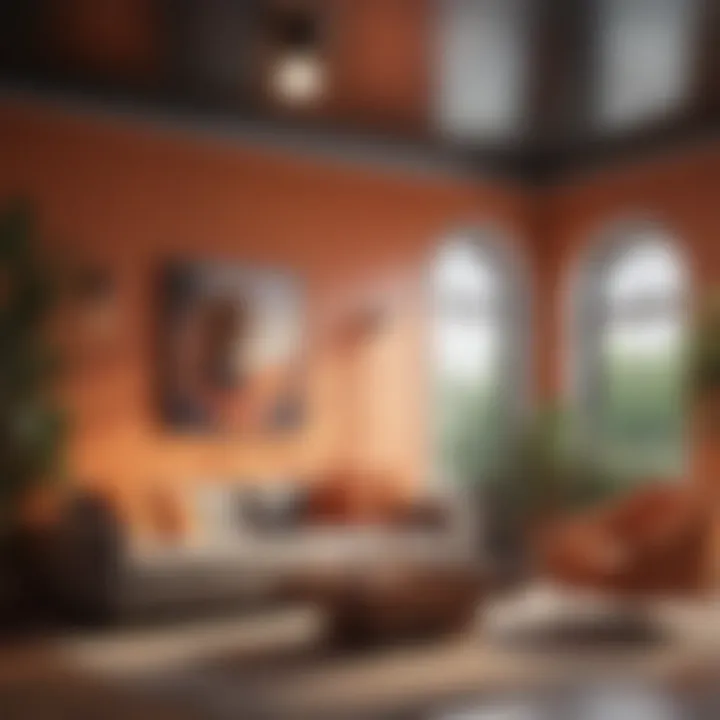
Intro
Choosing the right wall color for a living room is like picking out an outfit that reflects your personality. It’s more than just aesthetics—color has a profound impact on mood, atmosphere, and the entire ambiance of your space. Understanding how colors interact with natural and artificial light can transform the feel of your living room from cozy to expansive or from vibrant to serene.
A living room often serves as the heart of a home, where family gathers, friends meet, and memories are made. Consequently, the choice of wall color is a critical decision in setting the stage for those experiences. This guide aims to equip you with practical knowledge, inspiring ideas, and the latest trends to help you navigate the world of wall colors, ensuring your selection is both beautiful and functional.
Design Inspiration
Current Trends in Interior Design
In interior design, trends evolve, reflecting societal preferences and lifestyle changes. Currently, many homeowners gravitate towards neutral tones like soft grays, creams, and taupes. These colors exude an air of sophistication and versatility, allowing for easy transitions between various decor styles, whether minimalist or bohemian.
On the flip side, bold colors such as deep navy or rich burgundy are gaining traction, lending a sense of luxury and drama. These hues can create a striking feature wall that draws the eye and adds depth and character to the room. Mixing textures and materials—think wood, fabric, and metal—alongside these vivid colors enhances visual interest.
Color Schemes and Palette Ideas
When selecting a color palette, the aim is to strike a balance that aligns with your personal taste while ensuring harmony within the space. Here are a few ideas to consider:
- Monochromatic Scheme: Utilizing different shades of a single color can create a sophisticated and cohesive look. For instance, varying degrees of green can evoke a sense of tranquility and connection to nature.
- Analogous Colors: Choosing colors that sit next to each other on the color wheel fosters a sense of unity. Combinations like blue, teal, and green can produce a calming atmosphere, perfect for unwinding after a long day.
- Complementary Colors: Going for colors opposite each other, like blue and orange, adds vibrancy and energy. This approach works well in spaces meant for entertaining, as it can create an inviting atmosphere.
"Color is the keyboard, the eyes are the harmonies, the soul is the piano with many strings." — Wassily Kandinsky
While experimenting with color, don’t forget about the furniture and decor. Your selection should create a cohesive visual story. For instance, if you have navy walls, consider warmer, lighter-colored furniture as a counterbalance. This can prevent the space from feeling too heavy or closed-in.
Choosing the right wall colors can open up a dialogue with your living space. After understanding the current trends and finding inspiration in various color schemes, the next step is to consider practical applications and strategies for color selection in your home.
Prologue to Living Room Colors
When it comes to creating inviting spaces in your home, the choice of wall colors in your living room stands out as one of the pivotal decisions. Colors not only dictate the aesthetic appeal but also set the mood and atmosphere of the entire room. Think about it—when you enter a room with serene blues or vibrant reds, those colors immediately evoke feelings and thoughts. Therefore, understanding the nuances behind wall colors can be a game-changer for homeowners and design enthusiasts alike.
Many might approach wall color selection lightly, yet this choice can deeply influence how we experience our surroundings. Do you want your living room to feel relaxed and calm, or should it be a space filled with energy and creativity? A home is an extension of oneself, and colors serve as a powerful medium for expressing individuality.
The Importance of Wall Color
Wall color acts like the canvas in a painter's work. It’s the backdrop for all other decorative elements. When you choose a wall color, you set an overall tone for the space. For example, light shades can make a room appear larger, while darker colors tend to create a cozy, intimate ambiance. Colors also interact with natural and artificial lighting; as the day progresses, they showcase different hues and characteristics.
Moreover, the right wall color can complement your existing decor and furniture, creating a cohesive environment. For instance, a soft beige can harmonize beautifully with wooden furniture, while a striking navy blue can provide dramatic contrast with gold accents. Recognizing how colors can work together is essential for designing a living room that reflects your unique style.
Psychological Effects of Color
Colors have profound psychological effects on mood and behavior. According to color psychology, certain hues can stimulate feelings of comfort, happiness, or even anxiety. Consider the following insights:
- Blue: Often associated with calmness, blue can help promote feelings of tranquility, making it a great choice for relaxation.
- Yellow: Bright and cheerful, yellow can evoke happiness and positivity; however, too much can be overwhelming.
- Green: Symbolic of nature, green can create a refreshing atmosphere, instilling a sense of balance and harmony.
- Red: Bold and dynamic, red can increase energy levels but may also provoke agitation if overused.
"Colors are the smiles of nature." - Leigh Hunt
This insight echoes the importance of selecting the right hues for your living room to foster an environment that resonates with your desired emotional landscape. The impact of color is not just a surface-level consideration; it's about crafting an experience that feels just right.
Conducting some research and spending time reflecting on your preferences can pay dividends. Think about how certain shades make you feel. Ultimately, wall colors should reflect both your personality and the mood you aspire to create in your living space.
Color Theory Fundamentals
Understanding color theory is crucial when selecting wall colors for living rooms. It's not just about slapping a coat of paint on the walls; it's about creating an atmosphere that resonates with your sense of style and fulfills functional requirements. Color theory principles help decode how colors interact, how they can influence mood, and how they work together in design. With a grasp of these fundamentals, homeowners can make informed choices that brighten a room, highlight features, and create a cohesive look.
Primary, Secondary, and Tertiary Colors
When we break down color theory, we start with the basics: primary, secondary, and tertiary colors.
- Primary colors are the foundation of all other colors. These are red, blue, and yellow. By mixing these colors, you can create other hues.
- Secondary colors come from blending equal parts of two primary colors. For instance, mixing blue and yellow gives you green, red and blue create purple, and red with yellow produces orange.
- Tertiary colors arise when you mix a primary color with a neighboring secondary color. For example, a blend of red and orange results in red-orange.
Understanding this hierarchy allows homeowners and designers to experiment with their living room colors effectively. Using a mix of these colors thoughtfully enables a variety of moods and styles, making the walls an active participant in your living space.
Warm vs. Cool Colors
Another critical aspect of color theory is the distinction between warm and cool colors. The emotions each type evokes can't be ignored when curating a living room palette.
- Warm colors, which include reds, oranges, and yellows, tend to create a cozy, inviting atmosphere. These colors seem to advance into the room, making spaces feel more intimate, something particularly appealing for social gathering spots.
- Conversely, cool colors such as blue, green, and purple have a calming effect. They tend to recede, helping a room feel more spacious. Cool colors provide a serene oasis, ideal for relaxation after a long day.
Choosing between these two categories involves considering the desired ambiance of the living room. For example, if you aim to stir up energy and facilitate social interactions, warmer tones might catch your fancy. In contrast, should you wish to achieve tranquility, leaning into cooler shades could be the way to go.
"The color on your walls does more than frame your space; it shapes your experiences within it."
In summary, of keen understanding of color theory fundamentals is a prerequisite for anyone eager to explore living room wall colors. Whether you opt for bold primary hues or serene cool shades, these choices will ripple through your living room’s overall aesthetic, making it essential to consider your personality and lifestyle before painting.
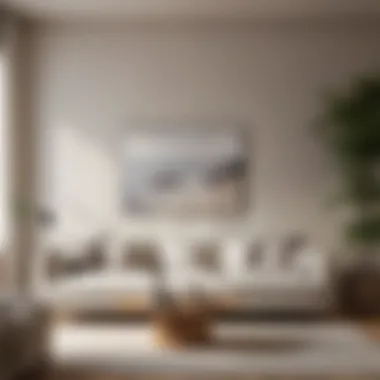

Popular Living Room Color Trends
In the realm of interior design, selecting the right wall color for a living room isn't just about aesthetics; it's also about creating a mood and a vibe for the space where one spends a considerable amount of their time. Popular living room color trends often reflect broader cultural shifts, personal choices, and seasonal influences. This section dives into the recent trends and their implications, providing homeowners and design enthusiasts with insight into creating an inviting and stylish environment.
Contemporary Neutrals
Contemporary neutrals have made a significant splash in modern living room design. These shades—like soft beiges, warm grays, and crisp whites—bring a sense of calmness and sophistication to a room. They form a versatile backdrop which allows accents and furnishings to take center stage.
Benefits of Contemporary Neutrals:
- Timeless Appeal: Neutral shades never truly go out of style. They offer a canvas that can adapt to changing tastes and decors.
- Increased Space Perception: Light colors can make a room feel larger and more open, reversing the claustrophobic effect smaller spaces can sometimes offer.
- Ease of Coordination: These colors make it simpler to mix and match with various styles and types of furniture.
This color trend is especially popular among those who desire a minimalist but elegant aesthetic. You can infuse character into a neutral palette with varied textures, from sleek fabrics to rustic woods.
Bold Accent Colors
On the flip side, bold accent colors are not only making waves but also setting the stage for self-expression in interior design. Think of splashes of deep navy, fiery red, or vibrant emerald green against a neutral backdrop.
Ideas for Incorporating Bold Colors:
- Feature Walls: Pick a wall to paint in a statement color to create focal interest without overwhelming the room.
- Cushions and Art: This can be an effective way to introduce vibrant hues without a full commitment. Decorative cushions, wall art, or even a colorful rug can punctuate the space beautifully.
- Furniture Pieces: A single bright chair or coffee table can serve as an eye-catching addition that enhances the overall design while allowing flexibility in alterations later on.
"Using bold colors strategically can give the illusion of depth and personality, transforming any bland room into a lively conversation area."
This trend invites homeowners to become playful in their color choices, and it adds a lively touch to create environments that encourage social interaction and relaxation.
Earthy Tones and Pastels
A growing interest in sustainability and natural living has paved the way for earthy tones in living rooms. Colors such as terracotta, olive green, and muted browns resonate with the beauty of nature. Meanwhile, soft pastels—think dusty pinks, light blues, and gentle yellows—bring a breath of fresh air to interiors.
Advantages of This Trend:
- Connection to Nature: These colors evoke a sense of peace reminiscent of outdoor settings, helping to bridge the gap between the interior and the natural world.
- Soothing Atmosphere: Soft pastels accomplish a serene vibe, making a space feel safe and welcoming—a perfect combination for a living room.
- Balance and Harmony: Both earthy tones and pastels can create a balanced atmosphere. Accent pieces in these shades provide great visual appeal without becoming overpowering.
By considering these trends when selecting wall colors, homeowners can craft their living spaces into havens of style and comfort, ensuring each choice reflects their unique taste and lifestyle.
Factors Influencing Color Selection
Color selection for living rooms is not simply an artistic choice; it's a balance of practical considerations and personal expression. Understanding the factors influencing color can prove invaluable in creating a harmonious space that reflects your style and serves its function effectively. From the dance of light across the walls to how ample or constricted a room feels, these elements shape the atmosphere of your living area.
Lighting Conditions
One of the most significant factors influencing wall color is lighting. Natural light, along with your choice of artificial lighting, dictates how colors appear during different times of the day. For instance, a color that looks rich and warm in daylight may seem overly cold under fluorescent lighting. It’s crucial to evaluate the type and direction of the light hitting your walls.
- Natural Light: Rooms with large windows may benefit from softer hues, like light blues or pale greens, which can reflect the warmth of sunlight.
- Artificial Light: Various bulbs create different color temperatures. For example, LED lights can appear blue, altering how a wall color looks compared to incandescent bulbs, which emit a warmer glow.
A handy tip is to test paint swatches on the wall, observing them at different times throughout the day. Remember, a sunny morning might transform a subtle shade into something vibrant, while dusk can dampen its effect.
Choosing wall colors without considering lighting is like buying shoes without trying them on—they might not fit right in your space.
Room Size and Layout
The size and layout of your living room significantly influence your color choices. Dark, bold colors can create an intimate feel, making a spacious room feel cozier; conversely, lighter colors can make a smaller room appear larger and airier.
- Small Rooms: Opt for light colors like whites or pastels to visually expand the space. A monochromatic palette can unify elements in the room without overwhelming it.
- Large Rooms: Feel free to experiment with deeper, richer colors to create zones within the space. Feature walls in a darker hue can add interest and delineate different areas, making the room feel more inviting.
Additionally, consider the layout of furniture. Open layouts may lend themselves to trendy, vibrant colors, while more compartmentalized spaces might benefit from a cohesive color story that flows from one area to another.
Existing Decor and Furniture
Before slapping a fresh coat of paint on the walls, take stock of your current decor and furniture. The colors already present can either clash or harmonize with your walls, so it’s essential to evaluate them.
- Complementarity: If you have a vibrant sofa or art pieces, consider selecting a neutral wall color to let those items shine.
- Style Harmony: The wall color should also align with the design theme in your room. Rustic furnishings might look best against earthy tones, allowing the natural elements to blend seamlessly.
- Color Coordination: Use a color wheel to find coordinating colors. This helpful tool illustrates how different colors can work together, providing a roadmap for keeping your decor cohesive.
Ultimately, your living room can serve as a canvas for your personal taste when you consider these various factors in your color selection. By keeping lighting conditions, room size and layout, and existing decor in mind, you’re much more likely to create a space that feels not only stylish but also functional.
Color Combinations for Living Rooms
The selection of color combinations in living rooms weighs heavily on the overall atmosphere of the space. It’s not merely about choosing a color and slapping it on the wall; it’s about creating a mood, setting the tone, and echoing personal style throughout the entire area. A well-thought-out color scheme can harmonize disparate elements, link various decor pieces, and ultimately unify the space. Whether cozy or vibrant, the right combinations can enhance a room's aesthetic appeal and its functionality, reflecting both personal taste and lifestyle needs.
Monochromatic Schemes
Monochromatic color schemes involve variations of a single color. This approach lends itself to a serene ambiance, which can be particularly beneficial in a living room, where relaxation is key. For example, if one chooses a calming blue, they can incorporate lighter shades like sky blue and deeper tones such as navy. This layered technique produces visual depth while instilling a gentle cohesiveness.
Here are a few advantages to using monochromatic schemes:
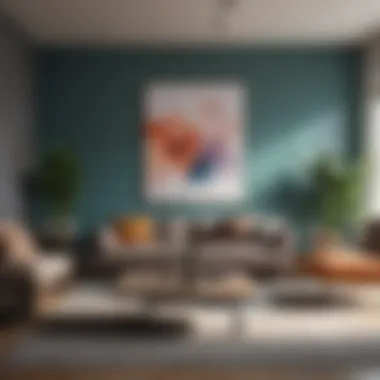
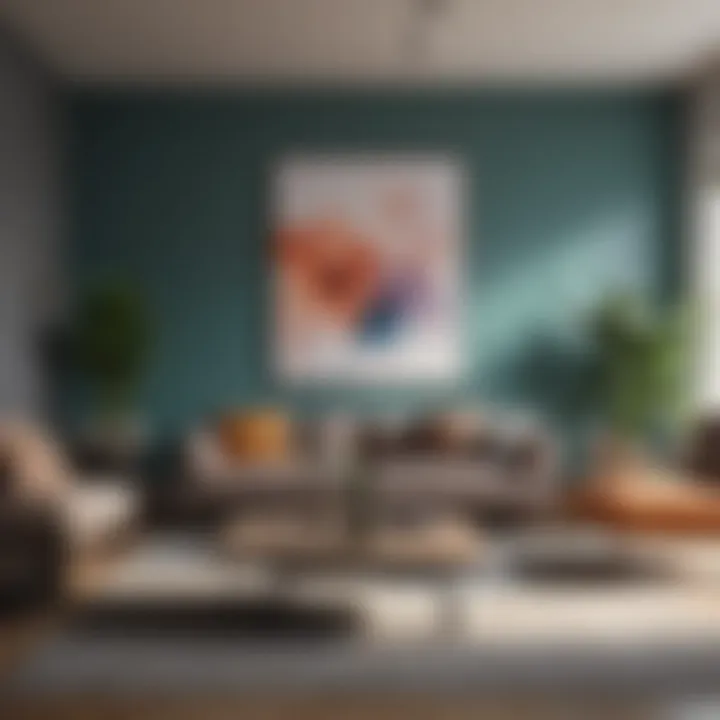
- Simplicity and Elegance: A single hue can create a refined look that's easy on the eyes.
- Flexibility: Allows for various textures and patterns in furniture and decor, without overwhelming the senses.
- Emphasis on Accent Pieces: Provides a solid backdrop for showcasing art or vibrant decor elements, letting them shine against a soothing sea of color.
However, a potential pitfall is to choose shades that are too similar, leading to a flat appearance. Ideally, it’s beneficial to use a diverse palette within the same color family to maintain interest.
Complementary Colors
Complementary colors sit opposite each other on the color wheel, creating striking contrasts that invigorate a space. For instance, pairing blue walls with orange accents can convey a dynamic energy that resonates well in social settings, perfect for gatherings or lively family interactions.
Here’s what you should consider with complementary colors:
- Visual Interest: Strong contrasts capture attention and can become conversation starters.
- Balance: The vibrant shades can be tempered with neutrals to avoid overwhelming the room, creating a nice balance.
- Energy and Vibrancy: This approach tends to evoke excitement and liveliness, ideal for more active environments.
Nonetheless, use caution. If the colors are too intense or used excessively, the space can feel chaotic rather than cohesive. Therefore, moderation is key. A bright chair or a throw pillow in a contrasting shade can go a long way without dominating the room.
Analogous Color Palettes
Analogous colors, which are adjacent on the color wheel, can create harmonious color combinations that feel naturally pleasing to the eye. For instance, pairing green with blue-green and yellow-green can generate a lush, organic feel reminiscent of nature.
Benefits of using analogous palettes include:
- Natural Harmony: These colors blend seamlessly and foster a laid-back, tranquil environment, suitable for comforting family space.
- Sense of Flow: The gradual transition from one hue to another maintains a coherent appearance, guiding the viewer's eye with ease.
- Versatility: It allows for creativity in design while providing plenty of options for introducing accent colors.
In summary, while analogous schemes can create a gentle and soothing atmosphere, it's essential to introduce enough difference between colors to avoid boredom. A well-placed piece of contrasting color, be it furniture or artwork, can invigorate the overall aesthetic, striking a balance between harmony and excitement.
Key Takeaway: When exploring color combinations, one should consider how colors interact with one another and what emotions they evoke. The choice of colors can transform a living room from a simple area into a refuge of personal expression.
Techniques for Visualizing Wall Colors
Selecting the right wall color for a living room can feel like trying to find a needle in a haystack. Each hue has its own personality, shaping not just the room’s aesthetic but also the moods of those who inhabit it. As such, the techniques for visualizing wall colors are indispensable tools in the decision-making process. These methods allow homeowners to see what their space might look like, helping to reduce the guesswork involved in color selection.
The benefits of effectively visualizing colors include clarity in decision-making, improved satisfaction with the final choice, and a significant reduction in costly mistakes. Understanding colors in their environmental context, as opposed to simply glancing at paint chips in a store, can make a world of difference.
Using Color Swatches
When it comes to selecting wall colors, color swatches are your first line of defense. A swatch lets you take a piece of the paint home, where it can interact with your lighting and existing decor. Here’s how you can effectively use color swatches:
- Choose multiple swatches: Bring home a range of shades, even of colors you might not think you like. This can often bring surprising results.
- Put them against the wall: Tape the swatches directly onto the wall at different times of the day to see how the color changes with varying light conditions.
- Observe in context: Place swatches next to your furniture and decor items to see how they complement or clash with other colors.
"A small swatch can inform, but a large wall can transform. Choices made in the store reflect differently when against your wall.”
This hands-on approach allows homeowners to engage with their environment on a deeper level. It encourages experimentation and nurtures a stronger bond with the feel of the home.
Virtual Design Tools
In this digital age, the use of virtual design tools has become increasingly popular among homeowners and interior enthusiasts alike. These tools allow you to visualize your living room in various colors without lifting a paintbrush. Here are some key aspects to consider:
- 3D modeling software: Programs such as SketchUp or Home Designer Suite enable users to create and manipulate 3D representations of their rooms. You can test different paint colors on walls and see how they interact with lighting and furniture.
- Augmented reality apps: Applications like Houzz or ColorSnap offer users the ability to paint walls in real-time using their smartphone cameras. This gives a clear representation of how each color will appear in situ before making a commitment.
- Mood boards: Create mood boards using tools like Canva or Pinterest. This can help in visualizing how various color themes harmonize with the overall design concept you have in mind.
Employing these virtual design tools helps to not only clarify your vision but also provides a platform for experimenting with creative ideas, resulting in a more personalized and satisfying living space.
Case Studies of Successful Living Room Designs
Exploring successful living room designs provides practical examples of how different wall colors impact overall aesthetics and functionality. Understanding these case studies aids in comprehending not just the individual choices made, but also the underlying principles of design that can be applied universally. Such insights can guide homeowners and interior design enthusiasts in making educated decisions when enhancing their own spaces.
A case study allows for an in-depth analysis of how wall color harmonizes with various elements—furniture, lighting, and even architectural style. This section will explore minimalist and maximalist approaches, showcasing how these contrasting styles utilize color differently to create distinct atmospheres.
Minimalist Approaches
Minimalism is all about achieving more with less, and this is especially true when it comes to wall color. A neutral palette with shades like soft whites, beiges, or very light grays can enlarge the visual space and create a serene environment. One inspiring example can be seen in a living room featuring Sherwin-Williams’ "Alabaster." This subtle tone reflects light beautifully, providing a warm backdrop that complements simple, tailored furniture.
Key Characteristics of Minimalist Living Room Colors:
- Simplicity Above All: The subtleties of light shades can create a calm, uncluttered space.
- Focus on Functionality: The colors should not distract but rather frame the essential elements in the room.
- Texture Over Color: In minimalist designs, textures and materials can often replace color as the focal point, making it crucial to choose wall colors that don’t overpower.
Choosing a minimal approach to your living room can help one find peace amidst the chaos of daily life, as the room becomes an oasis of calm. Though these neutral tones may seem bland to some, with carefully chosen artwork or plants, they can come alive beautifully.
"Less is more in the world of minimalism, allowing the beauty of simplicity to shine."
Maximalist Inspirations
Maximalism, on the flip side of the coin, revels in expressive color combinations and overwhelming visual aesthetics. Here, colorful walls can serve as the primary statement piece. Consider a living room adorned with Benjamin Moore’s "Bold Marigold" on the walls; it acts as a vibrant canvas that hosts an array of eclectic furniture and art pieces.
Characteristics of Maximalist Color Choices:
- Vivid Expressions: Utilizing bright shades and patterns adds life and energy to the room.
- Layering is Key: The art of layering colors, textures, and patterns creates a rich tapestry that feels dynamic and inviting.
- Personal Touch: Maximalism allows for individual expression, showcasing personal interests through furniture, art, and color.
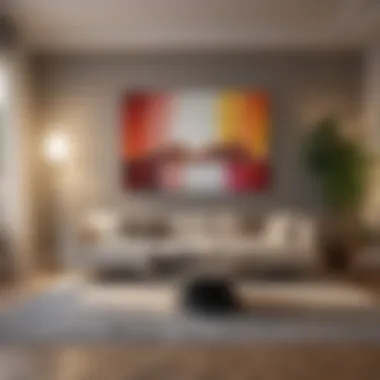

For those who crave bold, exuberant living spaces, maximizng colors makes it possible. Think of deep hues like navy blue or emerald green, framed by contrasting furniture pieces. This approach teaches the importance of balance, ensuring that even with such vibrant palettes, harmony is maintained. Few can deny the sheer joy that comes from a well-designed maximalist space, where each glance uncovers something new.
Ultimately, studying these two contrasting approaches can offer invaluable lessons about color choice. Minimalist designs speak to tranquility, while maximalist ones invite exuberance and energy. Both styles emphasize how thoughtfully chosen wall colors can create harmonious living spaces.
Common Mistakes in Choosing Colors
Choosing wall colors for a living room isn't just a trivial task; it can set the whole mood of your space. A mistake in this process can ripple outward, affecting not just aesthetics but also your overall comfort and satisfaction. Understanding common pitfalls can help you steer clear of regret and ensure your living space reflects your style and functionality needs.
Ignoring Lighting Changes
When selecting a paint color, one essential aspect that often gets swept under the rug is lighting. People frequently underestimate how natural and artificial light can alter the appearance of colors throughout the day. What might seem like a pristine blue in the morning can morph into a dull gray as evening falls due to changes in light intensity and angle.
Here are a few key points to bear in mind regarding light:
- Natural Light: Rooms with abundant daylight can make colors appear more vibrant, while those with limited sunlight may dull down tones.
- Artificial Light: Various kinds of bulbs can cast a golden or cooler hue affecting your wall's color perception. For instance, a warm yellow incandescent bulb can make a cool-colored paint look almost green.
- Direction: The orientation of your room also plays a significant role. A north-facing room usually receives cooler light, while a south-facing one tends to be warmer.
To avoid this mistake, consider testing paint samples at different times of the day to see how they play with light. Ultimately, striking the right balance will ensure your chosen color stays true to your vision, regardless of the time or lighting conditions.
Overly Trendy Selections
Another common pitfall is the allure of trends. Homeowners often get swept off their feet by the latest buzz in home décor, ultimately choosing a color that's "in" rather than what's genuinely right for their space. While it can be tempting to splash the walls with the newest Pantone color, it pays to remember that trends can be fleeting.
Here’s why leaning too heavily on trends can backfire:
- Longevity: Walls are not easily repainted. Colors that were all the rage last year may become outdated, leaving you with a color palette that feels stale.
- Personal Taste: What feels trendy might not align with your personal style. The key to a comfortable living area lies in the intersection of your unique aesthetic and functionality.
- Market Influence: Trends are often driven by marketing strategies, leading to choices that may not resonate with your lifestyle or the existing elements in your home.
Instead of solely following color trends, favor choices that resonate with you personally. Consider shades that you enjoy and that will create a happy or inviting atmosphere.
"Your home should be a reflection of who you are, not a catalog of someone else's vision."
Ingoing through the process of selecting a wall color, keep these common mistakes in mind. Always consider the lighting and how trends may influence your decisions. With careful thought, you can create a living space with colors that truly speak to your heart and stand the test of time.
Finale: Harmonizing Aesthetic and Functionality
When selecting wall colors for a living room, it’s crucial to strike a balance between aesthetics and functionality. A well-chosen color scheme does not only beautify a space; it also serves a practical purpose. It influences how people feel in the room. The way colors interact with natural and artificial light can alter perceptions of size and warmth.
In regards to both beauty and utility, one of the main elements to consider is how the selected colors will merge with existing decor and furniture. For example, a tranquil light blue could beautifully complement warm wood tones, creating a serene yet inviting ambiance. Without layering colors smartly, the atmosphere might come across as disjointed or even chaotic.
Moreover, thinking about the room's purpose is equally relevant. If you envision a space for relaxation, colors like soft greens or muted pastels could foster a peaceful environment. Alternatively, for an energetic space meant for lively gatherings, bolder shades like deep red or vibrant orange may serve better.
Creating a Cohesive Look
To create a cohesive look, it's essential to blend colors and textures in a way that feels harmonious. This involves considering the three main components: wall color, furniture, and accessories. A neutral wall provides a versatile backdrop that allows furniture pieces to shine, while colorful accessories can inject personality into the space without overwhelming it.
- Choose a common palette: Use a palette that shares a common undertone. For instance, if you have warm-colored furniture, consider soft taupe or warm whites for the walls to meld seamlessly.
- Be mindful of repetition: Ensure that the room reflects a consistent scheme. If you're accenting with reds, utilize it not just in one feature but perhaps in throw pillows, rugs, or even artwork to tie everything together.
- Balance is key: This doesn't always mean equal amounts of each color. Sometimes, a bolder statement wall can contrast with softer furnishings to create visual interest.
"Color is the keyboard, the eyes are the harmonies, the soul is the piano with many strings." – Wladimir Nabokov
The Role of Personal Preference
Undoubtedly, personal preference holds substantial weight in the selection process. Everyone has distinct tastes, and as such, blending personal preference with well-founded design principles can result in a uniquely personalized living space. This is where true style and comfort can flourish.
- Incorporate meaningful colors: For some, colors like rich emerald green or deep navy may evoke feelings tied to cherished memories, prompting comfort every time they enter the room.
- Experiment with shades: Don't be shy to play with shades that resonate with you, whether that means painting an entire room a vibrant hue or opting for accent walls to showcase an adventurous side.
- Invest in artwork: Select art pieces that reflect your personality. If you love abstract designs, these can serve as anchor points, allowing for a mix of other colors around them to sustain cohesion without sacrificing individuality.
Ultimately, marrying aesthetics with functionality is about respecting both your lifestyle and your personal inclinations. By understanding these elements and utilizing color thoughtfully, you create a living room that genuinely reflects who you are, while also serving its intended purposes.
Further Resources and Readings
When it comes to mastering the art of choosing living room wall colors, one of the significant aspects often overlooked is the importance of having further resources and readings at your fingertips. This knowledge can arm you with varied perspectives and deeper insights, allowing for a more thoughtful approach to your interior design journey. It's not just about throwing shade on the walls; it's about understanding the nuances of color, light, and how these components align with your personal tastes and lifestyle.
With resources ranging from books to online platforms, you can explore theories that explain why certain colors invoke specific behaviors or feelings, thereby adding layers to your selection process. This section aims to highlight valuable tools for homeowners, interior design enthusiasts, and those looking to rejuvenate their space or host gatherings that reflect their unique flair.
Books on Color Theory
Books can be a treasure trove of information when it comes to understanding color theory. These texts often lay the groundwork needed to appreciate the subtleties of color combinations and their psychological impacts. Here are a few notable titles:
- "Color: A Natural History of the Palette" by Victoria Finlay: This engaging read takes you on a journey exploring the history and significance of colors. It helps readers to appreciate color not just as a visual element but also as a part of cultural narratives.
- "The Art of Color" by Johannes Itten: A classic in the realm of visual aesthetics, this book combines color theory with real-life applications. Itten's approach offers a lens into harmonious color schemes, making it a must-read for any design aficionado.
"Color is the keyboard, the eyes are the harmonies, the soul is the piano with many strings." —Wassily Kandinsky
- "Color Power: Poppy’s Color Philosophy" by Poppy Green: This book delves into how colors can influence mood and environment. Poppy emphasizes practical applications for home decor, allowing you to create a vibe that aligns with your vision.
Exploring these texts can ignite inspiration and provide a foundation that guides your decisions when selecting the perfect wall colors.
Websites for Design Inspiration
In the digital age, a plethora of websites offer rich resources for design inspiration. These platforms allow users to visualize how different color schemes may pan out in real-life settings. Some worthy mentions include:
- Pinterest: This site is a goldmine for visual ideation. You can find boards dedicated to color palettes, helping you see how various combinations work together. The community aspect fosters not only ideas but also ways to implement creative designs.
- Houzz: This platform connects homeowners with design professionals and offers photos of projects. It's an excellent spot for viewing real homes that have successfully embraced unique wall colors, which may kickstart your imagination.
- Color Hunt: An easy-to-navigate website that offers curated color palettes. You can search for colors you love and even see how they combine with other shades
- Design Seeds: Through a stunning collection of color combinations inspired by nature, this site helps users see how existing hues harmonize. It's particularly useful for anyone feeling a bit lost in the color selection process.
Utilizing these resources can not only expand your knowledge but also help to generate fresh ideas that resonate with your aesthetic. Incorporating insights from books and online platforms can make the difference between a good choice and a stellar one; hence, invest a little time and exploration in these further resources.



